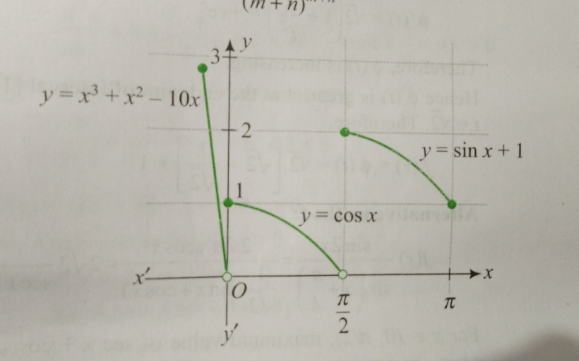Let the function be defined as follows:
A
a local minimum at x=
B
a global maximum at x=
C
a absolute maximum at x=-1
D
a absolute maximum at x=
Video Solution
Text Solution
The correct Answer is:C
Thus the graph of is

|
Updated on:21/07/2023
Topper's Solved these Questions
- BOOK - CENGAGECHAPTER - MONOTONICITY AND MAXIMA MINIMA OF FUNCTIONSEXERCISE - Exercise (Multiple)40videos
MONOTONICITY AND MAXIMA MINIMA OF FUNCTIONS
- BOOK - CENGAGECHAPTER - MONOTONICITY AND MAXIMA MINIMA OF FUNCTIONSEXERCISE - Exercise (Comprehension)42videos
MONOTONICITY AND MAXIMA MINIMA OF FUNCTIONS
- BOOK - CENGAGECHAPTER - MONOTONICITY AND MAXIMA MINIMA OF FUNCTIONSEXERCISE - Exercise 6.75videos
MONOTONICITY AND MAXIMA MINIMA OF FUNCTIONS
- BOOK - CENGAGECHAPTER - METHODS OF DIFFERETIATIONEXERCISE - Question Bank29videos
METHODS OF DIFFERETIATION
- BOOK - CENGAGECHAPTER - MONOTONOCITY AND NAXINA-MINIMA OF FUNCTIONSEXERCISE - Comprehension Type6videos
MONOTONOCITY AND NAXINA-MINIMA OF FUNCTIONS
Similar Questions
Knowledge Check
- Question 1 - Select One
Let the function f(x) be defined as follows:
f(x)=⎧⎪⎨⎪⎩x3+x2−10x−1≤x≤0cosx0≤x≤π/21+sinxπ/2≤x≤πAa local minimum at x=π/2Ba global maximum at x=π/2Ca absolute maximum at x=-1Da absolute maximum at x=π - Question 2 - Select One
Let f(x)=⎧⎪ ⎪⎨⎪ ⎪⎩x3+x2−10x−1≤x<0cosx0≤x<π21+sinxπ2≤x≤x Then at x=π2, f(x) has:
Aa local minimumBa local maximumCno extremumDno local maximum - Question 3 - Select One or More
Let f(x) = ⎧⎪⎨⎪⎩x3+x2−10x−1≤x<0sinx0≤x<x/21+cosxπ/2≤x≤π then f(x) has
Alocal maximum at x=π2Blocal minimum at x=π2Cabsolute minimum at x=0,πDabsolute maximum at x=π2
If f(x)={x2+10≤x<1−3x+51≤x≤2
View SolutionLet f(x)⎧⎪ ⎪ ⎪⎨⎪ ⎪ ⎪⎩−2sinx−π≤x≤−π2asinx+b−π2≤x≤π2cosxπ2≤x≤π
View SolutionLet f(x)⎧⎪ ⎪ ⎪⎨⎪ ⎪ ⎪⎩−2sinx−π≤x≤−π2asinx+b−π2≤x≤π2cosxπ2≤x≤π
View SolutionLet f(x) = ⎧⎪⎨⎪⎩x3+x2−10x−1≤x<0sinx0≤x<x/21+cosxπ/2≤x≤x then f(x) has
View SolutionConsider a function f(x) in [0,2π] defined as :
f(x)=[[sinx]+[cosx]0≤x≤π[sinx]−[cosx]π<x≤2π
where {.} denotes greatest integer function then.
Number of points where f(x) is non-derivable :View Solution

